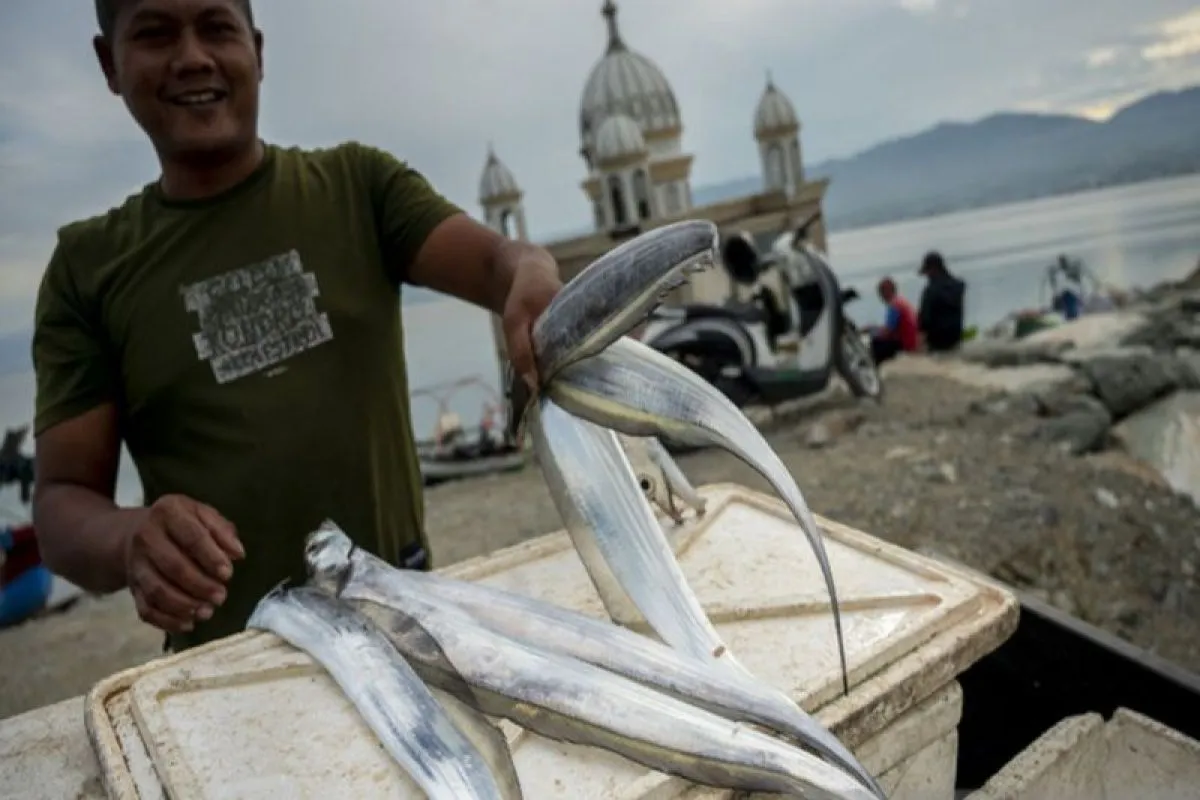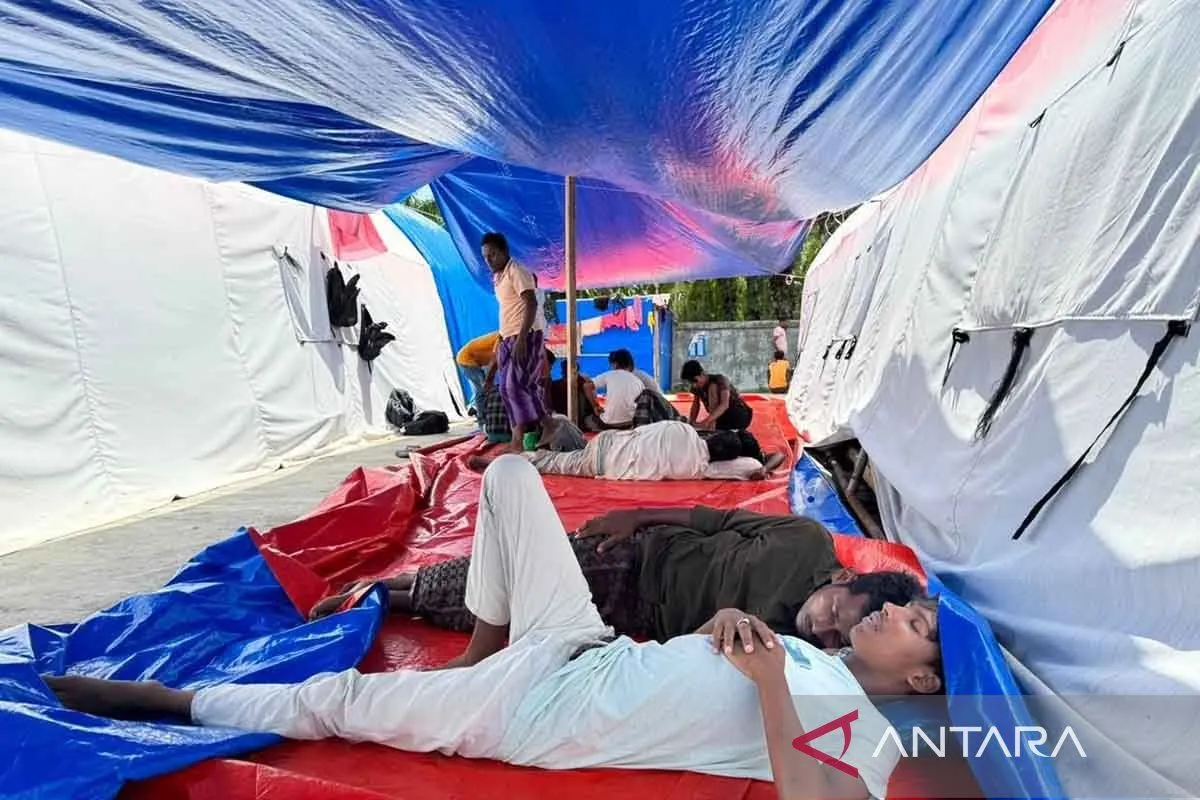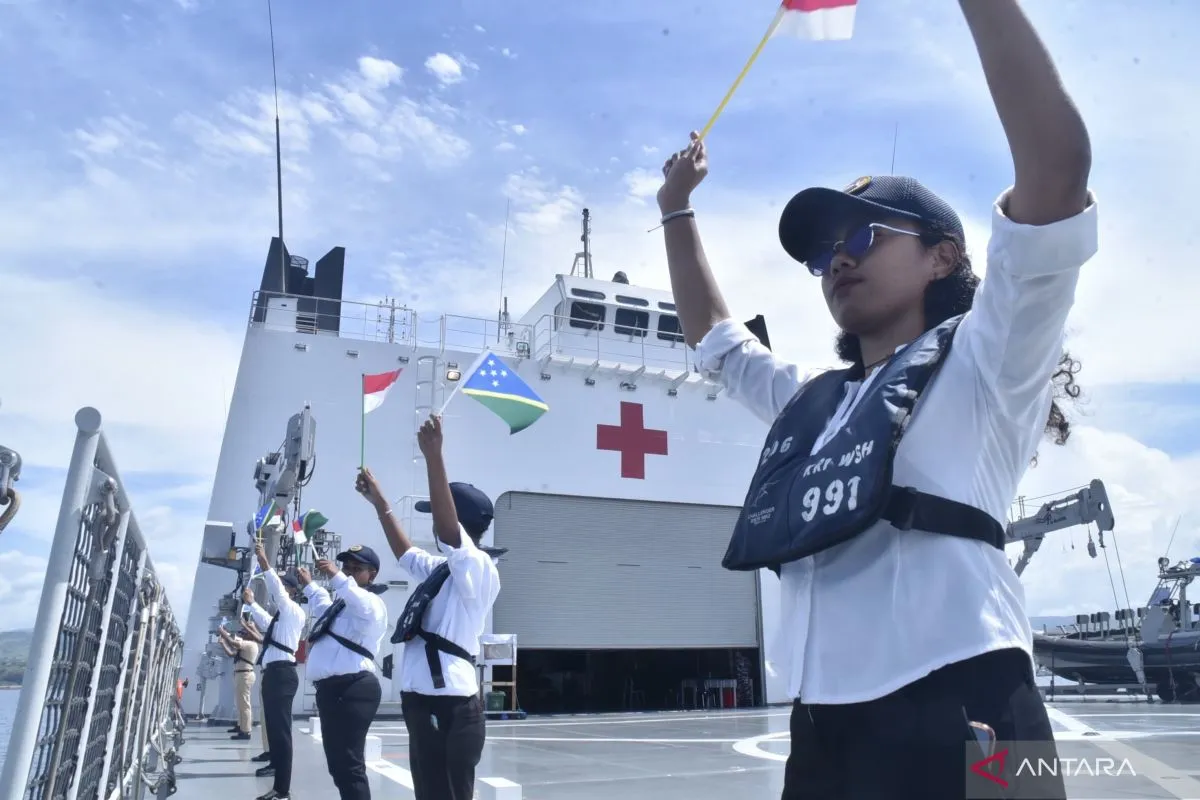Live Streaming
Program Highlight
Company Profile

Ahmad Faisal
November

Documentation—A trader shows 'luyur' fish (Trichiurus lepturus) collected from the beach at Kampung Lere, Palu, Central Sulawesi, on August 10, 2021. (ANTARA/Basri Marzuki)
VOI News, Jakarta: Food self-sufficiency is among the Asta Cita missions of President Prabowo Subianto and Vice President Gibran Rakabuming Raka.
Considering food as a primary need of the people, the government has begun preparing several strategies to build food self-sufficiency by 2028.
As reported by Antara News Agency (1/11), a number of ministries are working together to prepare a roadmap toward the noble mission, such as the Ministry of Agriculture, Ministry of Maritime Affairs and Fisheries, Ministry of Forestry, Ministry of Environment, National Nutrition Agency, Ministry of Public Works, Ministry of Villages and Development of Disadvantaged Regions, and the National Food Agency.
Amid the efforts to build food self-sufficiency, especially in staple foods, it is worth noting that Indonesia—as a maritime country blessed with a total sea area of more than 5.8 million square kilometers—has abundant underwater food resources.
The underwater resources also have diverse nutritional content that can support national food security as well as support human resource development through fish protein intake.
Source of nutrients
The nutritional content of fish, especially sea fish, is known to benefit growth. Fish are also rich in essential amino acids.
According to medical nutritionist Dr. Dyah Arum, sea fish, such as anchovies, mackerel, skipjack tuna, grouper, and ribbon fish, have high arginine content.
Arginine is an amino acid that helps support the growth of or increase in the height of children. In addition, it can help increase bone length.
Small fish, such as anchovies, have a calcium content of up to 2 thousand mg per 100 grams, which is far above that of milk. Long known as a good source of calcium, milk has 100 mg of calcium per 100 grams.
Unsalted anchovies can be an alternative source of calcium as their price in the market tends to be more affordable compared to milk.
Given the wealth of the sea, sea fish spread across various regions in Indonesia can support the food sufficiency target.
Freshwater fish are no less nutritious and can be considered a protein source for the community that can increase the quality of food intake.
Freshwater fish can also be a source of proteins. For example, catfish have a good fat content and are rich in omega 3.
Increasing production
Indonesia's natural marine wealth is indeed a blessing for its people. The Ministry of Marine Affairs and Fisheries has initiated a movement to popularize eating fish and educate the people about including fisheries products in their daily menus.
While the utilization of sea fish to boost nutrition is permissible, in the process, it is also necessary to implement fishing practices that focus on the sustainability of fish resources, including the underwater world.
Fishing should be carried out in environmentally friendly ways so that the areas where fish live and breed can be maintained.
Based on data from the Ministry of Maritime Affairs and Fisheries, in the first half of 2024, capture fisheries production reached 3.11 million tons of seawater fish catch and 0.23 million tons of inland water fish catch.
The increase was recorded at 12 central technical implementation units fishing ports and 66 regions dominated by sea fish, including tuna, skipjack, mackerel, and scad.
Meanwhile, the target for capture fisheries production for 2024 is 6 million tons — 5.64 million tons for seawater fish catch and 0.38 million tons for inland water fish catch.
With this achievement, state revenue from capture fisheries as of July 26 was recorded at Rp533.36 billion against the target of Rp1.85 trillion.
Meanwhile, in the January–June 2024 period, production in Indonesia's aquaculture sub-sector reached 3.34 million tons, or 26.6 percent of the target of 12.5 million tons.
With the achievement of aquaculture still far from the target, the Ministry of Marine Affairs and Fisheries has prepared a strategy to accelerate performance, so that the target can be met in the second half.
Aquaculture commodities are supported by seaweed commodities (5.14 million tons), snapper (3,860 tons), tilapia, catfish, milkfish, carp, gourami, and grouper.
Given the abundance and variety of marine and fishery commodities, it is only right for Indonesia to utilize the wealth of underwater food resources.
When it comes to taste, fish protein consumption can be increased through diversification so that people have a variety of food menus.
In fact, data from the World Food Agency (FAO) shows that the world's population is experiencing a food shortage, with hunger affecting 7.9 percent of people globally in 2019 and 9.2 percent in 2022. This is also predicted to increase the world's protein needs by 70 percent.
The wealth of fish resources is also expected to support the world's protein needs, which are projected to increase.
Before moving on to meet the world's protein needs, it would be good to introduce fish proteins more closely to the domestic community, so they can become king in their own country. (Antara)
November

Rohingya immigrants at a temporary shelter at Seunebok Rawang village, East Pereulak district, East Aceh Regency, on Friday (November 1, 2024). (ANTARA/Hayaturrahmah)
VOI News, Aceh: At least 91 Rohingya immigrants, who were left stranded on the coast of Meunasah Hasan village in East Aceh District, have been relocated to a temporary shelter at Seunebok Rawang village's soccer field.
"At the temporary shelter, there are also dozens of other Rohingya immigrants who previously landed in Kuala Parek, East Aceh District," head of the East Aceh Civil Service Police Unit, T. Amran conveyed on Friday as reported by Antara News Agency (1/11).
The immigrants were relocated using two trucks at 8 p.m. local time on Thursday.
Meanwhile, the bodies of six Rohingya immigrants who died on the beach of Meunasah Hasan village were buried in the public cemetery at the village, Amran informed.
He urged the relevant stakeholders to help handle the Rohingya immigrants, who are seeking a better life from the security crisis in Myanmar, to prevent such incidents from happening again.
"It is possible that the arrival of Rohingya immigrants is only to seek legality as refugees. Then, seek asylum in another country," he noted.
A ship carrying dozens of Rohingyas was found stranded on the coast of Meunasah Hasan village, Madat district, East Aceh Regency, Aceh province, on Thursday.
The Rohingyas were found ashore at around 4 a.m. local time. Dozens of them were taken off the ship. They then swam to the shore of the village. (Antara)
October

Personnel from the Pacific port visit task force raise the flags of Indonesia and the Solomon Islands as the KRI Dr. Wahidin Sudirohusodo-991 docks in the Solomon Islands on Friday (October 25, 2024). (ANTARA/HO-TNI AL Fleet III Command Information Service)
VOI News, Jakarta: Indonesian naval warship KRI Dr. Wahidin Sudirohusodo (WSH)-991, a part of the 2024 Pacific port visit task force, arrived in the Solomon Islands on Friday.
The ship is on a goodwill mission in the Solomon Islands, the first stop in its South Pacific tour.
As quoted by Antara News Agency (25/10) Head of the information service of the Indonesian Navy's Fleet Command III, Lieutenant Colonel (S) Ajik Sismianto, informed that the mission will involve delivering medical aid packages, providing free health services, conducting blood donation drives on board the ship, and hosting an open house for the Solomon Islands community.
"We hope this activity runs smoothly and successfully, setting a positive precedent for future missions and fostering strong relations between our two countries," Navy Colonel (P) Arif Prasetyo Irbianto, commander of the Pacific port visit task force, conveyed in a statement.
KRI WSH-991, a hospital ship from Fleet Command III (Koarmada III), traveled 1,909 miles from Sorong, Southwest Papua, to reach Solomon. The journey took eight days.
At Honiara Pier, Navy Colonel (P) Edi Herdiana, the commander of KRI Dr. Wahidin Sudirohusodo-991, invited Indonesian citizens in the Solomon Islands and local residents on board.
Colonel Herdiana led a tour of the ship's facilities, which include a Type C hospital.
Indonesian Navy personnel and students from Papua, who are participating in the goodwill mission, are scheduled to visit historical sites in Solomon, such as the Vilu Military World War II museum, during their stay.
During the voyage from Sorong to Solomon, Indonesian Navy personnel received training in various areas, including basic first aid, surface danger combat roles, unit development competitions, operational law, and rules of engagement for overseas missions.
In addition to Solomon, KRI WSH-991's mission includes visits to Fiji, Vanuatu, and Papua New Guinea.
The ship will provide social services, renovate places of worship, offer free health services, and distribute medical aid packages in each country it visits.
KRI WSH-991 will also host receptions on the ship's deck, featuring traditional Indonesian dances and cuisine. (Antara)
October

VOInews, Jakarta: Political expert from The Faculty of Social and Political Sciences at Gadjah Mada University and a steering committee member of MOSAIC (Muslims for Shared Action on Climate Impact), Abdul Gaffar Karim, Wednesday (23/10/2024) optimistic that President Prabowo Subianto and Vice President Gibran Rakabuming Raka can address climate change issue in Indonesia through collaborative efforts.
"Our hope is that there will be a continuation from the previous government, particularly with an emphasis on green and blue economies," he stated in a statement, acknowledging the urgency of the climate crisis.
Indonesia has set ambitious climate goals, aiming to reduce greenhouse gas emissions by 29% by 2030 and achieve net-zero emissions by 2060. These targets are critical, particularly given Indonesia's status as one of the world's largest carbon emitters due to deforestation and reliance on fossil fuels.
However, Gaffar is acutely aware that government initiatives alone are not enough. He stresses the necessity of collaboration among various stakeholders, including government entities, the economic sector, civil society, and local communities. "Governments often prioritize physical development, such as infrastructure projects. Meanwhile, the economic community adheres to a global framework for sustainability, being mindful of carbon emissions and environmental degradation," he elaborated.
He further emphasized that local communities play a vital role in implementing these initiatives, as they are often the first to experience the impacts of climate change. This connection, he believes, is essential for creating a robust and effective response to climate challenges.
"The government can continue its infrastructure and policy initiatives, corporations can maintain their operations, and society can remain actively engaged," he said.
At MOSAIC, Gaffar and his colleagues are actively working to bridge the gaps between these sectors. "What we are doing at MOSAIC is strengthening collaboration among diverse parties," he said.
Despite the strong commitment of society to environmental issues, Gaffar noted that the three sectors—government, business, and civil society—often function independently. "Collaboration is essential," he asserted, highlighting MOSAIC's role in promoting cooperation, particularly among Islamic community groups.
The organization brings together various Islamic organizations and civil society elements, including Muhammadiyah and Nahdlatul Ulama, alongside academic institutions like Universitas Gadjah Mada (UGM). "Each organization has its own commitment to environmental issues. We are still exploring how these institutions can collaborate more effectively," he remarked.
MOSAIC has initiated several concrete actions to combat climate change, including programs like "sedekah energi" (energy donation) and "wakaf hutan" (forest endowment). "These programs serve as practical models for Islamic philanthropy while collectively addressing climate change challenges," Gaffar explained.
Gaffar reiterated the importance of collective action. "Islamic philanthropy can serve as a vital channel to address climate change in Indonesia," he concluded. "By fostering collaboration and commitment, we can develop impactful solutions that benefit both our communities and the environment," he said.
He also underscored the pivotal role of the government in this endeavor. "It is crucial for the government to enhance collaboration on climate change initiatives, starting with straightforward and actionable steps, such as fostering a more proactive partnership between the Ministry of Environment and Forestry (KLHK) and the Ministry of Religious Affairs," he said.

